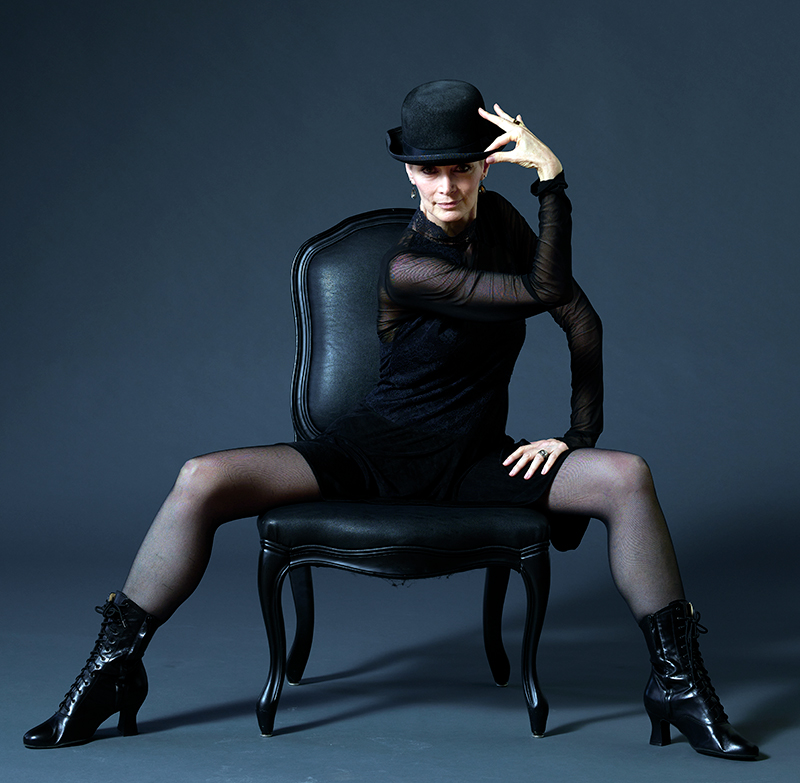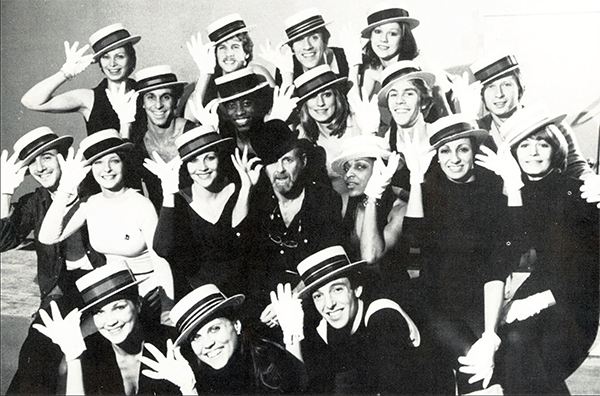
A Kansas City dancer who was discovered by Bob Fosse in the 1970s has been charged with making sure a new revival of a show she danced in is faithful to the late choreographer’s distinctive style.
Bob Fosse’s Dancin’ opens April 19 at the Old Globe Theater in San Diego in preparation for opening on Broadway. Christine Colby Jacques was in the original 1978 cast of Dancin’, which ran for more than four years on Broadway. Jacques was hired by the revival’s director, Wayne Cilento, who also was in the original cast, to teach the new cast the original dance numbers in the true style of Fosse, which has been lost in many modern interpretations of his work.
Jacques, who has lived in Kansas City since 1993, grew up in Cincinnati. After high school, she toured with Disney on Parade until she saved enough money to move to New York, where she began her career as a Radio City Music Hall Rockette.
In addition to Dancin’, Jacques performed on Broadway and in the first national tour of Fosse’s Sweet Charity and in the first national tour of the Broadway show Fosse. Some of her television and film credits include A Chorus Line, Annie, All That Jazz, and The Tonight Show. She was the first guest artist to appear with the Kansas City Ballet, performing as The Vamp in Todd Bolender’s Souvenirs.
Jacques holds a BFA from the University of Kansas and lectures there in the Department of Theatre and Dance. IN Kansas City caught up with her by phone from the Fairway home she shares with husband, Steven, and their dog, Gelsey.
Growing up, were there dancers in your family?
My mom was a dancer in high school, but she never talked about dance. She went to nursing school and became a nurse. But her baby sister became the professional dancer and danced at the Copacabana in New York City. She was tragically killed in a car accident.
When did you become interested in dance?
My mom took my older sister to dance class, and she had a little trouble remembering the combinations. I used to watch dance routines on variety programs on TV and I could pick up the routines easily. So, my mom decided to enroll me in the class so I could help my sister with the steps. And I got hooked. I was three.
Three?
[Laughs.] I was three. They usually didn’t enroll children that young, but the teacher could see that I could do the steps, so she let me in.
Let’s jump straight to 1978 when you debuted on Broadway in the original cast of Dancin’. How did that happen?
I was going into Luigi’s (Jazz Dance Centre in New York) to take a class—Luigi usually had 30, 40 people in one class—and there were maybe eight or ten people. I said to the teacher, “Where is everybody?” And he said, “Oh, they’re probably at that audition.” And I said, “What audition?” And he said, “Bob Fosse’s doing a new show.” And I said, “You probably have to sing, right?” And he said, “No, they are just looking for dancers.”
And I thought, “Crap! How did that get by me?” So, I took class and afterwards I bought a trade paper and found the listing, and they were going to have more auditions. So, I went.
What was the audition like?
It was like that scene in the movie A Chorus Line where the line wraps around the building. It took forever to get inside. And when I auditioned, I was on the stage for seven hours. I made all the cuts. They invited us back for callbacks, and it was another seven hours on the stage. I made it through all the cuts again. They said, “Congratulations, we’ll call you all back in two weeks and then you will sing.”
When we came back, I didn’t have a song, because my agent said we didn’t have to sing, and I just didn’t think we would really have to do that. I just didn’t believe it. I also thought if it got to that point, I could just leave. I was heading towards dance company work, not Broadway.
What I didn’t realize was that after 21 hours of auditioning, I wouldn’t want to walk away. So, when it came time to sing, I said, “I’m not really a singer. I’m a dancer.” And they said, “We don’t care. We’re looking for dancers. But we have to know what your range is, how you will blend with other people. Sing anything, sing Happy Birthday.” So, I did.
You sang Happy Birthday?
I sang Happy Birthday—as did some other people. And I made everybody laugh, I did a cute little thing. I felt humiliated, but I felt good about myself for having risen to the challenge instead of giving up. Two weeks later Mr. Fosse called me at home.

No way.
Yeah, way! Himself.
He was such a big star in show business at that time, as a director, choreographer, dancer, actor. And yet he was the kindest, most respectful man to audition for. Every time a group of three would go, if he didn’t want someone, he would walk up to the person and in a soft voice say, “Thank you very much for coming. I can’t use you this time.” And to the other people, he would say, “Thank you very much. Would you wait over here?”
And in a group of three if one person made a mistake, he would ask the group to do it again—he truly gave everyone a fair shot. And I felt that was what he did with me. Because I was new to him. He was empathetic because he, too, had been a dancer in no-one-knows-who-I-am auditioning mode.
When he called, because I had sung Happy Birthday, he invited me to a private audition with him and the musical director where he put me through some vocalizations, and then we tried a song from the show and my voice had little quivers in it, but after a bit I was singing without the quivers.
A couple of days later, he called me at home and hired me.
Let’s jump forward to 1986, when you worked with Fosse again on the Broadway revival of Sweet Charity. The role of Ursula March, which you performed as an understudy in addition to dancing in several numbers, is described for casting purposes as a “Hot-headed and jealous girlfriend of Italian movie star Vittorio Vidal. Must be a strong and versatile comedic actress and a good mover.” How is being a good mover different from being a good dancer?
Oh! Because movement conveys character.
How?
So, this girl [Ursula Marsh] is a model, and she’s spoiled and she’s wealthy and she’s used to being given all kinds of attention—that all has to be conveyed by movement. Her head is up, her shoulders are down and back, she walks with confidence—each step is deliberate.
For the new revival, Bob Fosse’s Dancin’, which opens this month at the Old Globe in San Diego, your mission was to train the dancers in the “real” Fosse style. What is the real Fosse style, and how has it been altered over the years?
When Fosse directed dancers, there was a certain quality of contained energy. I would liken it to a car that’s in neutral, but somebody has their foot on the gas. The car is at rest, but you can feel the engine revving. You don’t over-dance. You don’t push. You don’t mug. You don’t contort your face.
That might make it sound easier, but it is actually harder. It takes more stamina to execute his moves in the detail they require. If you look at Bob’s work, and you go, “Oh that’s so sexy when they stick their hip out and do that little hip circle or a little hip thrust forward and back.” Dancers tend to really go for it, and that is not a correct execution.
As a dancer you should be holding in your mind an image as to why your hips are doing that, and it will always have nothing to do with being sexy or feeling sensual. When you add that to an unforced expression on your face, that keeps it from being grotesque. Fosse is never grotesque. He’s never overtly sensual or sexual. When the dancer holds back, that is when the irony comes in. There’s a lot of humor in [Fosse’s] movement. He takes ordinary movement and bumps it up and then it becomes funny, because the audience thinks, “I’ve seen people do that!”
There’s a step in Rich Man’s Frug (in Sweet Charity) where you flex your wrists in a section that’s called The Boxer. Imagine if you had boxing gloves on and the only way to pull up your satin trunks is to flex both wrists and put them against your pants and kind of pull up a little bit. Fosse made a whole step out of that.
How do some dancers get Fosse wrong?
Some were trained to dance Fosse as hard and as big as they can, and that is not Fosse’s real style. Fosse was about pulling it in, not about showing off.
What was it like teaching the dancers who are doing the new revival?
Very exciting. We were in New York in the summer. We were working with kind of a skeleton crew. The goal was to get the dance up on its feet and let [director and original cast member] Wayne Cilento see what it looked like. Then I came back in November and taught the material to the real cast. Wayne is recreating a number that was cut from the original production, and it is masterful. I get teary-eyed because I think there might be some purists who say, “That’s not how it was,” but I think he’s brought it into the 21st century and he’s melded in a lot from Bob’s other shows and TV and film work. The poster says: “The moves he invented. Reinvented.” I think it’s going to be the most exciting thing on Broadway.
Is there a time frame for when it might open on Broadway?
From what I know I think fall of 2022 or spring 2023.
As a dancer, what do you think is Bob Fosse’s most important legacy?
I think his legacy is a unique dance vocabulary that is identifiable to everyone. You don’t even have to be a lover of musical theater or dance to recognize Bob Fosse’s work.
And his second legacy is approaching dance as an actor, looking at every step: Where did this movement come from? Why am I doing it? How do I get the right dynamic? How do I get something to be provocative but not obnoxious? When you’re dancing Fosse, you’re not thinking, “I’m dancing, and everyone gets to watch me dance.” You’re thinking about conveying a character or an attitude or an environment through movement, and you’re asking yourself, “What do I need to do to convey that properly?” Those are the two biggest things that he’s left.
Interview condensed and minimally edited for clarity.


